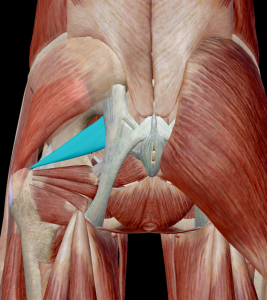- Forget about medical doctors when in musculoskeletal pain; use Google DuckDuckGo, a good chiropractor and systematic exercise.
- Open-sourcing my condition has been a total flop.
- Here’s the good news: I’m much better.
As you might remember, a couple of months ago I put as many details as I could think of on this blog about the (literal) pain in my butt that had been torturing me for months. Friends told me it was a bad idea — customers will stop buying from you, that kind of thing. But then, I don’t like to pretend, about health or otherwise. We’ll see whether those negative consequences will actually occur (so far they have not). But fast-forward to now, and some results are in.
First of all, open-piriformis.org — a wiki I set up with the intention to collaborate with others on this and similar conditions — has been a total flop. Some visitors, but no engagement whatsoever. I don’t know why that is. Perhaps because my condition is fairly unique (although I doubt it). Or, because people — particularly people in pain — are not quite ready to mentally disengage from the hoped-for “my doctor will fix it” and actually work to figure it out themselves. Be it as it may, I’ll probably shut down the wiki shortly, there is no point, and perhaps the world is not ready for open-source-style healthcare.
Speaking of doctors, my experience with the medical establishment related to this condition has been totally and utterly negative. I’ve seen one general practitioner, three “specialists”, and many supporting radiologists and what have you, all of whom charged considerable (outrageous?) amounts of money, helped me not at all, and in one case, made my pain significantly worse. In the other cases, I didn’t let them do what they wanted to do to me, all of which — I have good reasons to believe — would at best have tapered over the problem, and at worst would have made me perpetually, and substantially even worse.
Don’t believe me? Take the most egregious example, which is apparently one of the standard forms of treatment for Piriformis Syndrome: cutting the tendon of the Piriformis muscle. To understand what this does, I want you to take a good look at the pictures of the deep muscles in your pelvis and compare with the sailship below.
(This is your pevis, from behind, skin removed. The big Gluteus maximus and medius muscles are removed on the left side, so we can see what’s inside the butt. The Piriformis muscle is in blue.
To undestand the surgery, follow the Piriformis to the left. Where it attaches to the bone, that’s where the cut is made so it becomes lose on the left side. The muscle is left in place.)
(This is a picture of a sailship from Wikipedia. Notice the similarity to the butt? Some rigid elements — bones in the pelvis, masts and horizontal yards on the ship — connected by lots of flexible elements — muscles, tendons, ligaments vs. sails and ropes. Everything extremely flexible so that the ship, just like the human body, can function is many different winds and positions.)
Now imagine that for some reason one of the many ropes on the sailship gets really tight. If medical doctors were on that ship, what would they recommend? The Piriformis treatment of course: cut the tight rope, and let it swing freely!!
If you were one of the seamen up on that yard, like in the picture, I think you do know what you would do the minute you are back down: Keelhauling, I think, used to be the standard treatment for that kind of thing.
Why? Because it’s immediately obvious to everybody (not counting doctors) that the rope is tight for some reason that we better find out. It’s not the rope’s fault it is tight! It’s that it’s attached to something that pulls in the other direction with all its might. Now if you cut that tight rope, then … do I need to continue? You end up with the exact opposite of what you were attempting to do:
In case of the sailboat, your mast may break. (Contrary to lay opinion, the mast does not stay up straight because it is so strong, but because it is held there by ropes. If you cut one of those, and the wind is just right, say bye to your mast.)
In case of the human pelvis, some other muscle will probably be recruited to fill in for the incapacitated Piriformis. The Piriformis was overloaded already, so how will that substitute do? Hard to think it could do any better. Instead, everything will become even more asymmetric. Imagine that sailship again, but with some key ropes missing and flexible masts: it will make a sorry, one-sided picture and probably sink in the next storm.
Google produces 85,000 results for Piriformis surgery fail. Wonder why?
What’s the correct answer? If asked this way, it’s totally obvious. You do what you would do on that sailship: find out why that rope is so tight. Chances are that some other rope isn’t doing its job, or some other rope (in the other direction) is too tight or too short, or perhaps that the entire rigging wasn’t set up symmetrically. Imagine if one of the masts on that ship wasn’t standing up vertically: you bet some of the ropes would have funny stresses on them as soon as the wind blows.
Which is what I have been doing. My excellent chiropractor (shout-out to Rick Mehaffy) pointed out that my SI Joint was misaligned, and has adjusted it about twice a week. If your SI Joint is misaligned, it’s very similar to one of those masts on the ship being at the wrong angle. And with lots of stretching and exercise, I’m working hard on getting the rest of the “ropes” to the right length, strength and mobility. I love Assess and Correct, which is worth its $127.
Guess what? My Piriformis has completely stopped bothering me. I still have a bunch of pains all around my pelvis, but the Piriformis is FINE! If this doesn’t support my theory above — including “why do we let people cut other people if they don’t seem to understand even the basics of how the things they are cutting are supposed to work?” — then nothing will. I have not gone back to these “specialists” and asked them how that is possible. I don’t even want to know what they would say.
So I’m much better, I expect continued improvement, and all in spite of the demigods in white. Who seem to be better at billing than at healing. As a side effect of this ordeal, I have found out a lot about Tensegrity, which is fascinating and fully underappreciated except at the fringe, for no good reason. Expect another post on that one.

